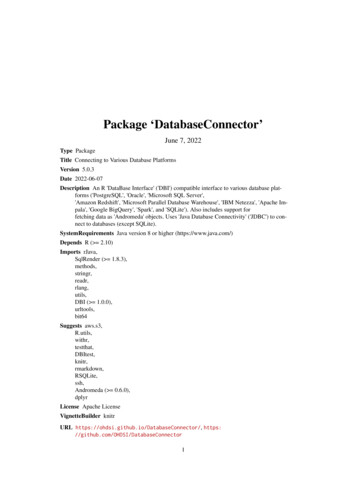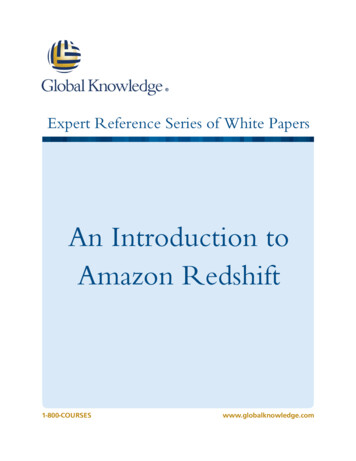
Transcription
Expert Reference Series of White PapersAn Introduction toAmazon Redshift1-800-COURSESwww.globalknowledge.com
An Introduction to Amazon RedshiftRich Morrow, Global Knowledge Instructor, Cloud and Big Data AnalystIntroductionLike any "big data" initiative, deploying and operating a data warehouse of any size used to be limited to onlylarge enterprises with deep budgets for proprietary hardware and multi-year software licenses. Pay-as-you-gocloud products like Google's BigQuery and AWS's Amazon Redshift change all of that, putting a fully blown, fullymanaged data warehouse within reach of even the smallest business.But do commodity costs equal cut-rate performance? Can even large enterprises rely on these for workloads thatcurrently run out of commercial solutions like Oracle Exadata and Teradata? How is security and latency affectedin a hybrid environment? In this article, we focus on Amazon Redshift, with an introduction into what it is (and isnot), as well as how it compares with the costs, performance, support for third-party visualization tools, scale,and reliability.What is a Data Warehouse?Data storage and analysis is typically bifurcated into two types of systems, known as Online TransactionProcessing (OLTP) and Online Analytical Processing (OLAP), both of which are terrible acronyms that need a bit ofexplanation. OLTP is about serving real-time (low latency), high concurrent connections—traditionally served byRelational DataBase Management Systems (RDBMSes) like MySQL and Oracle. OLAP systems, on the other hand,are characterized by longer-running, more complicated queries against probably much larger volumes of data. AnOLTP system could provide the data layer for a customer-facing web or mobile app so that the customer couldcomplete a transaction; whereas an OLAP system serves internal users who are typically doing data mining inorder to extract business intelligence analytics. Some examples of OLAP queries are “tally and sort all sales bysalesperson by region by product for all of 2013,” or “find the lowest margin products by category by region forQ3 2014”—data which could be used to either calculate salesperson bonuses or decide which product lines toterminate. For a reasonably busy retailer, either of those queries could involve sorting through terabytes of data(which probably exist in a couple of disparate, siloed, and perhaps even proprietary systems), and could takehours or maybe even days to run.The hardware and software underneath these OLAP systems is what we refer to as a data warehouse (DW),which is sometimes also referred to as an enterprise data warehouse (EDW). Technically, OLAP refers to theoperation being performed, while an EDW is the static hardware and software to support OLAP operations,although many refer to EDW systems as OLAP systems as well. These systems have very different considerationsthan OLTP systems—they need to be able to store and process dozens, hundreds, or maybe even thousands of TBof data, as cost-effectively as possible, and they need to be able to handle very long-running, complicated queriesacross those large data sets. EDW administrators also need to be able to easily and cost-effectively grow thestorage and processing capabilities as their business grows.Data generated from the OLTP systems is periodically (hourly, daily) copied into the EDW system via Extract,Transform and Load (ETL) operations meaning that the amount of data in an EDW grows very quickly (see figure1). For this reason, the “cost per TB” of storage in an EDW has always been a big consideration.Copyright 2014 Global Knowledge Training LLC. All rights reserved.2
Figure 1: Internal and external customer needs served by OLTP, then moved (via ETL) into DW, which is used by internal customers forBusiness Intelligence.In the pre-cloud days, any business hoping to do BI queries had to fork out millions to purchase the EDWhardware and software from a limited number of companies. The makers of these EDW systems could (and did)pretty much charge the maximum they could, and because of their high cost, businesses had to be very selectiveabout what they chose to put into their EDW.To serve queries as fast as possible, the EDW systems also needed to “pre-materialize” the data into what isknown as “OLAP Cubes”— essentially cells representing the data for one of many dimensions. Figure 2 shows anexample of such a cube, where we can see that the customer (dimension 1) “Fred Smith” purchased 234 digitalcameras (product, dimension 2) in the month (dimension 3) of January. The downside of this pre-materializationmeant that should the BI users also maybe like to add a fourth dimension (say region) to the cube, all of the datawould need to be re-calculated—a process that could burn up hours or days (taking the system offline in theprocess), and result in much, much more data needing to be stored. Because adding an additional dimensionoften doubled or tripled the size of the stored data, some businesses had to keep their cubes limited to manyfewer dimensions than they would have liked to analyze.Copyright 2014 Global Knowledge Training LLC. All rights reserved.3
Figure 2: An OLAP cube showing the number of products purchased by specific customers for specific monthsWhat is Amazon Redshift?Perhaps one of the most exciting outcomes of the public cloud was addressing the shortcomings of traditionalEDW storage and processing. The fast provisioning, commodity costs, scalable, and pay-as-you-grow pricing ofpublic cloud are a natural fit for EDW needs, providing even the smallest of users the ability to now get valuableanswers to BI questions. Amazon Redshift is one such system built to address EDW needs, and it boasts low costs,an easy SQL-based access model, easy integration to other AWS services, and most importantly, high queryperformance.Amazon Redshift gets its name from the astronomical phenomenon noticed by Hubble, which explained theexpansion of the universe. By adopting the Amazon Redshift moniker, AWS wanted to relay to customers thatthe service was built to handle the perpetual expansion of their data.An Amazon Redshift cluster consists of one leader node (which clients submit queries to) and one or morefollower (or “compute”) nodes, which actually perform the queries on locally stored data. By allowing forexpansion of follower nodes, Amazon Redshift ensures that customers can continue to grow their cluster as theirdata needs grow. Customers can start with a “cluster” as small as a single node (acting as both leader andfollower), and for the smallest supported instance type (a DW2), that could be as low cost as 0.25/hour orabout 180/month. By using “Reservations” (paying an up-front fee in exchange for a lower hourly running cost)for the underlying instances, Amazon Redshift can cost as little as 1,000/TB/year—upwards of one-fifth to onetenth of the cost of a traditional EDW.Because Amazon Redshift provides native ODBC and JDBC connectivity (in addition to PostgresSQL driversupport), most third-party BI tools (like Tableu, Qlikview, and MicroStrategy) work right out of the box. AmazonRedshift also uses the ubiquitous SQL language for queries, ensuring that your current resources can quickly andeasily become productive with the technology.Copyright 2014 Global Knowledge Training LLC. All rights reserved.4
Figure 3: Amazon Redshift Architecture (Source: docs.aws.amazon.com/redshift)Amazon Redshift was custom designed from the ParAccel engine—an analytic database which used columnarstorage and parallel processing to achieve very fast I/O. Columns of data in Amazon Redshift are stored physicallyadjacent on disk, meaning that queries and scans on those columns (common in OLAP queries) run very fast.Additionally, Amazon Redshift uses 10GB Ethernet interconnects, and specialized EC2 instances (with betweenthree and twenty-four spindles per node) to achieve high throughput and low latency. For even faster queries,Amazon Redshift allows customers to use column-level compression to both greatly reduce the amount of datathat needs stored, and reduce the amount of disk I/O.Amazon Redshift, like many of AWS’s most popular services, is also fully managed, meaning that low-level, timeconsuming administrative tasks like OS patching, backups, replacing failed hardware, and software upgrades arehandled automatically and transparently. With Amazon Redshift, users simply provision a cluster, load it withtheir data, and begin executing queries. All data is continuously, incrementally, automatically backed up in thehighly durable S3, and enabling disaster recovery across regions can be accomplished with just a few clicks.Spinning a cluster up can be as simple as a few mouse clicks, and as fast as a few minutes.A very exciting aspect of Amazon Redshift, and something that is not possible in traditional EDWs, is the abilityto easily scale a provisioned cluster up and down. In Amazon Redshift, this scaling is transparent to thecustomer—when a resize is requested, data is copied in parallel from the source cluster (which continues tofunction in read-only mode) to a new cluster, and once all data is live migrated, DNS is flipped to the new clusterand the old cluster is de-provisioned. This allows customers to easily scale up and down, and each scaling eventnicely re-stripes the data across the new cluster for a balanced workload. In a traditional, hosted EDWenvironment, a resize would typically involve weeks of preparation and days of downtime, along with a hefty sixor seven-figure bill.Copyright 2014 Global Knowledge Training LLC. All rights reserved.5
Amazon Redshift offers mature, native, and tunable security. Clusters can be deployed into a Virtual Private cloud(VPC), and encryption of data is supported via hardware accelerated AES-256 (for data at rest) and SSL (for dataon the wire). Compliance teams will be pleased to learn that users can manage their own encryption keys viaAWS’s Hardware Security Module (HSM) service, and that Amazon Redshift provides a full audit trail of all SQLconnection attempts, queries, and modifications of the cluster. The AWS CloudTrail service additionally logs allAPI calls against Amazon Redshift, and both the native SQL logs and AWS CloudTrail logs can be exported andqueried.Now that we know what Redshift is, let’s also clarify what it is not. It is not a NoSQL engine. It is not a suitablesolution to search through large collections of text documents. It is not an RDBMS, nor is it intended to serveOLTP for external customers. It is not a real-time analysis engine. It is not a good place to store anything butstructured data. It is not the fastest way to analyze data, nor is it the cheapest way to store data. Instead, it is acloud-based EDW that allows internal users to quickly perform business analytics on large collections of bothrolled-up and granular data.Amazon Redshift vs. Other SolutionsWhen building an overall big data architecture, an EDW is just one piece of the puzzle, and to add to theconfusion, some of the other pieces in that architecture overlap in some ways. In the public cloud alone, you’lloften find EDW products like Amazon Redshift compared or contrasted against Hadoop, text search engines likeSolr, NoSQL engines like DynamoDB, and real-time analysis engines like Kinesis. To really understand whereAmazon Redshift fits among these other technologies, we need to understand the raison d’etre of each.As a batch analysis data platform, Hadoop is probably the product that compares most directly to AmazonRedshift. Although both exploit horizontal scaling to perform parallel batch (non-real-time or “offline”)processing, the approaches and benefits of each are quite different. Front and center is the storage paradigm.Amazon Redshift requires users to impose RDBMS-like table structure around their data, but Hadoop imposes nosuch structure. In Hadoop, users can load structured (think tables), semi-structured (think e-mails, with somestructure but a big blob of text in the body), or unstructured (think graphics or CLOBs) data in the cluster.For processing, Hadoop uses the somewhat dated MapReduce paradigm, which is now coming up on its tenthbirthday. Although programming in MapReduce requires knowledge of both MapReduce and a programminglanguage like Java, users can leverage Hive— another Apache project which imposes table-like structure onHadoop data, and exposes SQL as the access method. Under the hood though, Hive just takes the SQL queriesand converts them to the somewhat slow MapReduce processing model.At a high architectural level, Hadoop is much, much more than Amazon Redshift. It has a very rich ecosystem,comprising many other Apache projects that can do everything from real-time data analytics to workflows toproviding alternate Domain Specific Languages or DSLs like the Pig project. Whereas Amazon Redshift is focusedon providing an easily managed EDW, Hadoop is focused on providing a general purpose “data hub,” which canservice many different types of workloads. Hadoop is generally hailed as the cheapest way to store and processdata, but many workload comparisons show Amazon Redshift as comparable. Depending on the workload,Amazon Redshift can even be both significantly faster and cheaper than Hadoop.At AWS, Hadoop can be provided by either custom-building your own cluster on top of EC2 (virtual servers), orby leveraging the Elastic MapReduce (EMR) service—a fully managed Hadoop cluster with many of the “managedservice” benefits of Amazon Redshift. If you have a true EDW need, however, Amazon Redshift will serve youmuch better and more cost effectively than even EMR.Copyright 2014 Global Knowledge Training LLC. All rights reserved.6
Text-based search is a very different need than an EDW, and to fill this need, many mature products like ApacheLucene, Apache Solr, and Elastisearch already exist. In AWS, text search is provided via the Amazon CloudSearchservice, which is essentially a fully managed, pay-as-you-go deployment of Solr. When you need to allow yourusers to perform detailed text searching (faceting, highlighting, weighing, sorting, etc.) on large collections oftext documents, choose one of these text search technologies.Amazon Redshift is sometimes incorrectly referred to as a NoSQL database, but make no mistake, it is mostdefinitely not. NoSQL databases like Apache CouchDB, Apache Cassandra, and AWS’s own DynamoDB are adifferent beast—mainly aimed at providing real-time, low-latency responses to a high number of external userqueries. You’ll often find NoSQL used in combination with an RDBMS, where the “hot” data (with highthroughput or high volume requirements) resides in the NoSQL solution and data requiring more transactionalcapabilities (rollbacks, ad-hoc querying needs) is stored in the RDBMS. Many AWS users leverage DynamoDB fortransient, high throughput needs like user sessions, mobile gaming statistics, and the like. Again, AmazonRedshift differs dramatically from this use case in that it focuses on read-heavy analytical processing. For an EDW,Amazon Redshift is very fast (returning results in seconds or minutes), but it’s never going to be as fast as aNoSQL solution (returning results in milliseconds) that was designed specifically for this purpose.Real-time data analysis is all the rage these days, and for very good reason—businesses find real value in beingable to respond more quickly to trends. Real-time analysis engines like Spark/Shark, Storm, and AWS Kinesistypically analyze data in memory as it flows through the ingestion phase. Often just the results of that analysisitself are persisted to disk, and the raw data is discarded. The number one benefit of these “analysis on ingestion”engines is that they can accomplish much faster analysis on extremely large volumes of data. For example, take acompany wishing to monitor its brand reputation by analyzing tweets that contain their corporate name andselect products. This company could filter the Twitter fire hose, just saving off all relevant tweets and thenanalyzing the results either hourly or weekly in something like Amazon Redshift. However, if it’s really importantthat the company respond quickly to negative tweets, they may want to use the Kinesis service, which wouldprovide such insight (and the ability to respond) in real time.Where Amazon Redshift Fits in the EnterpriseWith the recent explosion of data storage and processing technologies, many of which overlap in some ways, it’seasy to be confused about how, where, and when to leverage an EDW in general or Amazon Redshift inparticular. Having many options can be both a blessing and a curse, but a cloud-based EDW like Amazon Redshiftstill has a very important and distinct role in an Enterprise.The sweet spot that any EDW occupies is business analytics. Any business has some very important metrics that itneeds to collect and report on for historical determinations of which areas/sectors/products/divisions are doingwell and which are not. Obviously, the metrics we need to collect in such a system are but a small subset of theoverall metrics that other divisions like marketing, IT, and app development teams need.From a raw dollars per terabyte cost perspective, Hadoop will likely remain unbeatable—it’s hard to get lowercost than commodity hardware running open source software. For this reason, a lot of organizations are movingtheir “big data” architectures to resemble figure 4 below.Copyright 2014 Global Knowledge Training LLC. All rights reserved.7
Figure 4: Amazon Redshift as a downstream consumer of Hadoop.In this architecture, data from our OLTP systems are no longer put directly into the EDW (Amazon Redshift in thiscase), but instead first flow directly into Hadoop. Because Hadoop is a more general, lower cost tool, we canboth store huge amounts (petabytes) of data in it, and allow multiple downstream systems and users to pull datafrom it, or analyze data directly in it.In this architecture, our BI-specific metrics would be copied from the Hadoop “data lake” into Amazon Redshift,where our BI folks could run their workloads. Hadoop can act as a consolidation area for the data before it goesinto Amazon Redshift, whereby users get much more responsive results by querying smaller amounts of data, andthe business saves costs by storing the bulk of their data in Hadoop. Users such as marketing, still wishing toextract value from either BI or non-BI specific data, can still go fishing in the data lake, and remove some of theload from Amazon Redshift.With AWS Direct Connect capabilities (the ability to rent a dedicated, secured 1 or 10Gb line directly from acorporate datacenter into AWS), and VPC (a secured, cordoned-off private cloud which allows full control ofnetwork topologies, routes, and NACLs), enterprises can run really any part of such an overall architecture eitheron-premises or in the public cloud. Even if an organization has significant internal investments in Hadoop andruns all other aspects of their business from their own cost-effective data center, flowing the BI subset of thatdata into Amazon Redshift and pointing BI users to that new endpoint is incredibly easy to do, and almostguaranteed to save dollars—possibly a lot of dollars—in the form of avoiding future EDW hardware and softwarepurchases.Copyright 2014 Global Knowledge Training LLC. All rights reserved.8
Third-Party Tool SupportOne of the main reasons it’s so easy to transition from a traditional on-prem EDW to Amazon Redshift is thethird-party tool support. The vast majority of BI users don’t run their queries directly against the EDW. Instead,they leverage tools like Tableau, QlikView, MicroStrategy, TIBCO Jaspersoft, and others which provide point andclick, visual interfaces that make the EDW a whole lot more accessible, easy to navigate, and easy to extract valueout of. In addition to providing visualization capabilities, most of these tools also allow for easy loading and datatransformations as well.Because of its open standards JDBC and ODBC connectivity, Amazon Redshift natively supports all of theaforementioned leaders in the BI visualization tool space as well as many, many others.Transitioning to Amazon Redshift can literally be a couple of days of effort, the very last step of which wouldbe repointing the BI users to the Amazon Redshift endpoint. From that point forward, it would be completelytransparent to the BI users that the back-end EDW is now hosted in public cloud (assuming, of course, that theyhave a good, stable, secure low-latency connection, like Direct Connect, to that public cloud). AWS’s generoustwo-month free trial of Amazon Redshift also makes it very low risk for companies to test and compare AmazonRedshift by migrating some of their EDW data into Amazon Redshift and then running their own cost andperformance benchmarks.ConclusionAmazon Redshift is one of the most talked about and fastest growing services that AWS has ever released, andhopefully we’ve been able to relay to you some of the big reasons why. Amazon Redshift opens up EDWcapabilities to even the smallest of businesses, yet its costs, security, and flexibility also make it appealing to thelargest of enterprises.It allows companies to easily, conveniently scale their EDW needs both up and down, and as a managed service,allows your team to offload all of the “undifferentiated heavy lifting” of building and maintaining an EDW. Itsraw storage costs are about one-fifth to one-tenth of traditional in-house EDW, and AWS has taken great care toensure its performance is still competitive with those in-house solutions.Before deciding to use Amazon Redshift, however, it’s important to understand what it is and is not. There is agreat deal of misunderstanding and outright misinformation on the web, and one needs to take great care inwhere and from whom they are getting their information. In addition, public cloud services like Amazon Redshiftcontinue to evolve, and there is great risk in getting outdated information as well—all the more reason to ensureyou’re getting information either directly from AWS or from an AWS-approved partner like Global Knowledge.Learn MoreLearn more about how you can improve productivity, enhance efficiency, and sharpen your competitive edgethrough training.Architecting on AWSArchitecting on AWS - Advanced ConceptsSystems Operations on AWSDeveloping on AWSBig Data on AWSVisit www.globalknowledge.com or call 1-800-COURSES (1-800-268-7737) to speak with a Global Knowledgetraining advisor.Copyright 2014 Global Knowledge Training LLC. All rights reserved.9
About the AuthorRich Morrow is a 20-year open-source technology veteran who enjoys coding and teaching as much as writingand speaking. His current passions are cloud technologies (mainly AWS and Google Cloud Platform) and big data(Hadoop and NoSQL), and he spends about half of his work life traveling around the country training theFortune 500 on their use and utility. He leads the Denver-Boulder cloud computing group, as well as quicloud, acloud and big data consultancy firm.Copyright 2014 Global Knowledge Training LLC. All rights reserved.10
(VPC), and encryption of data is supported via hardware accelerated AES-256 (for data at rest) and SSL (for data on the wire). Compliance teams will be pleased to learn that users can manage their own encryption keys via AWS's Hardware Security M odule (HSM) service, and that Amazon Redshift provides a full audit trail of all SQL
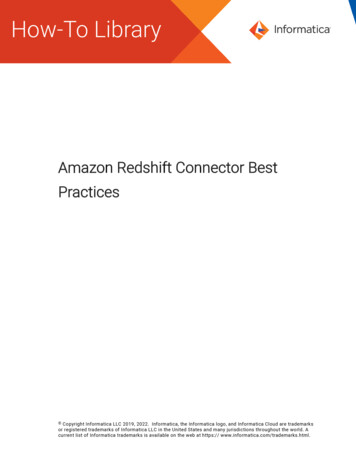
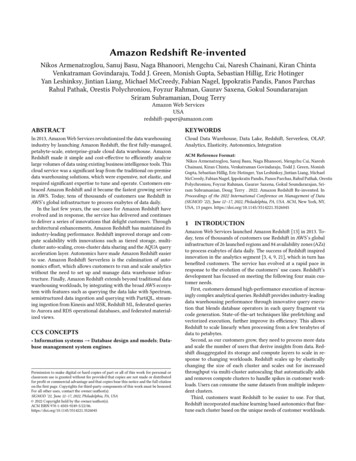
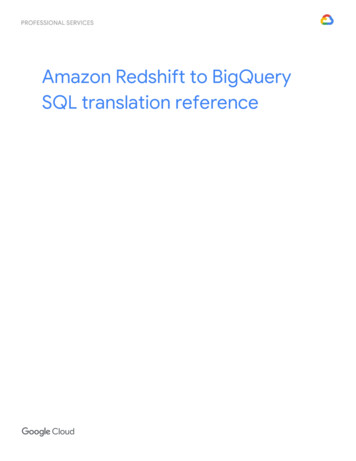
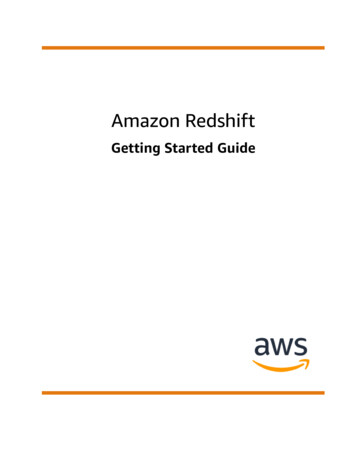
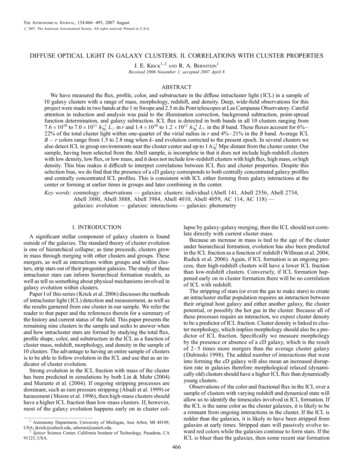
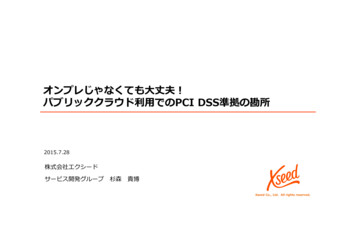

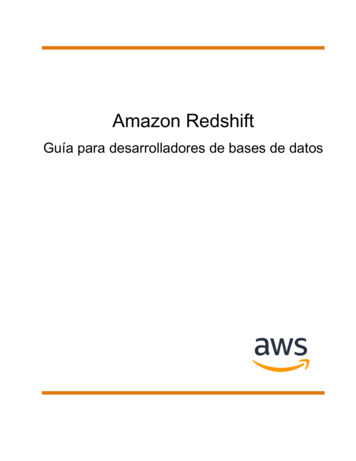
![Index [beckassets.blob.core.windows ]](/img/66/30639857-1119689333-14.jpg)

